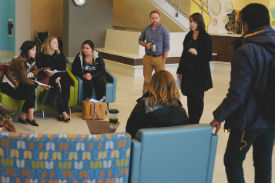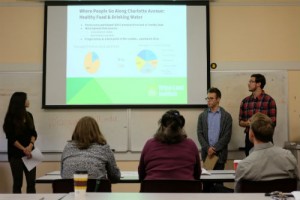
This fall, students from Vanderbilt University conducted research that might well shape future development along one of Nashville’s key corridors. Examining a stretch of Charlotte Avenue running west from downtown, graduate and professional students, as well as undergraduates, conducted a nutritional survey, met with neighborhood representatives, and identified successful ‘Building Healthy Places’ practices of other cities to inform local recommendations.
Among their conclusions: the sections of Charlotte Avenue studied are sorely lacking in grocery stores and fresh foods, while restaurants and markets generally do not offer healthy food or, if they do, are unaffordable or difficult for many residents to access.
People who live along the corridor are proud of their neighborhoods’ culture and diversity but also worry about safety and lighting, traffic congestion, access to and reliability of public transportation, gentrification, attractiveness, and a lack of social spaces for youth.
The work was part of an initiative undertaken by the Nashville District Council of the Urban Land Institute, an international nonprofit organization. Rose Faeges-Easton, director of the Nashville District Council, says ULI acts as a convener for developers, bankers, attorneys, and city planners to professors, residents and others who exchange knowledge about best practices in the use of land and the creation of sustainable, thriving communities.
“The goal of this ULI Nashville initiative is to help community partners and stakeholders envision a healthier, cohesive, safer and more livable corridor and to help identify implementation steps on how to achieve that. ULI does not lobby. Instead, ULI collaborates to educate and communicate what can be and how that helps build thriving and sustainable cities.” says Faeges-Easton.
The Charlotte Avenue project is part of ULI’s Building Healthy Places initiative. Supported by a grant from ULI and the Robert Wood Johnson Foundation, Nashville is one of four cities selected to envision Demonstration Corridors that might serve as models for revitalization and mixed-use development elsewhere. The other cities awarded grants are Boise, Idaho; Denver, Colo.; and Los Angeles, Calif.
Currently, Charlotte Avenue offers an eclectic mix of retail, healthcare businesses and related nonprofits, along with residential neighborhoods and a fair amount of unused land and old warehouses. ULI Nashville’s work is intended to inform (re)development of the thoroughfare in a way that will meet the needs of residents and be sustainable as Nashville continues its rapid growth.
“We began doing background work early in 2015,” says Faeges-Easton, “and we wanted to develop a community outreach element. We also knew we needed additional human resources, and that’s where Vanderbilt comes in.”
Among the members serving on the ULI Nashville BHP Grant Management Team for the project is John Vick, an epidemiologist with Nashville’s Metro Public Health Department. As an alumnus with both a master’s degree and a Ph.D. from Vanderbilt’s Peabody College of education and human development, Vick thought Vanderbilt could supply the research power ULI Nashville was looking for.
“One of Nashville’s greatest assets is its universities, and from the outset of the project we wanted Vanderbilt to be involved. Partnerships between universities and the community are mutually beneficial. The students learn how to apply what they’re learning in a real-world context, and the community benefits directly from their work,” says Vick. “The action research classes taught at Peabody take this approach, so they seemed like an ideal partner for our initiative.”
Vick approached Kimberly Bess in Peabody’s Department of Human and Organizational Development. In addition to her own studies of how community-based organizations can build capacity to improve systems and better peoples’ lives, Bess teaches undergraduates and graduate students how to conduct action research—research with a specific intention of fostering positive change.
Bess’s class sections in the fall included 20 undergraduates and 12 graduate or professional students, with master’s students drawn from programs in community development and action, international education policy and management, global health, and economics. Collectively, they made an excellent team to take on some of the work needed by ULI Nashville.
“In our courses on human development we don’t just talk about change at the individual level,” says Bess. “Environment has an enormous impact. This project with ULI Nashville was appealing because it offered us an opportunity for students to train in research methods that can capture valuable information across an entire community.”
Bess’s students did legwork for three components of the project.
In October, they surveyed businesses along the corridor as part of a food audit to assess the availability of healthy food, grocery stores and restaurants. Part of their classwork involved first identifying a tool they could use to conduct the audit. They decided on the Nutrition Environment Measures Survey (NEMS) created at the University of Pennsylvania.
Another team of students met with residents and representatives of several neighborhood associations and public housing developments along Charlotte to discuss what they perceived to be the particular strengths and weaknesses of community life.

A third group of students conducted research to identify previous development projects, either national and international, that may serve as models for Nashville planners and developers working to establish a long-term strategy. Among the case studies they made use of were projects in Austin, Texas, Jackson, Tenn., Albert Lee, Minn., and Seattle, Wash., as well as Australia, the Netherlands, and the United Kingdom. The students recommended that ULI Nashville establish clear metrics so as to design for impact; create people-centered developments with public spaces and pedestrian- and bike-friendly paths; incorporate health features into building and community design along with health promotion initiatives and educational programming; and respect the heritage and existing character of the Charlotte corridor.
The students presented the results of their work to members of the Building Healthy Corridors Action Council in December.
“As Nashville continues to grow rapidly, it becomes even more important for policy-makers and businesses to have quality data on which to base decisions that can strengthen our community,” says Bess. “This research opportunity is great preparation for our students, but it’s also a way for Vanderbilt to share knowledge and give something back to Nashville.”